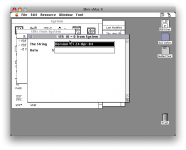Thank you for all the research, folks!! System 3.0 really was a shakeup...new fonts, disappearance of fonts, HFS coming out...yeah, that last one just *may* be a big deal with that update...
Regarding NY 36, I liked it as a newsletter font, especially as the only true 36 point font in the lineup.
Speaking of enlarging Athens...Print Shop actually did exactly that in banner mode. Athens was the default font for banners. Not only did it get enlarged, it could be split into patterns. Each character could be made of multiple bricks, designs, smiley faces, you name it! Given its blockiness, Athens was a decent choice for this purpose.
Print Shop for Mac honestly didn't get a lot of coverage in the press (schools loved it though). I don't even remember any Mac books having sections on Print Shop (there was a review in MacWorld circa 1987 that I dug up once if that counts). It's a pretty fun little program, one of the first I had on the Mac after having been a veteran of the Apple II version. The graphics are top-notch, too.
Why include a font file? Simple--they used a lot of those fonts in the ready mades. I'm surprised Brøderbund included Seattle in their file, as it was Microsoft's font!


